2015 NISSAN LEAF weight
[x] Cancel search: weightPage 11 of 412

1. Rear head restraints/headrests (P 1-5)
2. Child restraint anchor points (for top tetherstrap child restraint) (P 1-32)
3. Roof-mounted curtain side-impact supple- mental air bags (P 1-36)
4. Seat belts (P 1-8) 5. Front head restraints/headrests (P 1-5)
6. Seat belt pretensioners (P 1-49)
7. Front seats (P 1-3)
8. Supplemental front-impact air bags (P 1-36)
9. LATCH (Lower Anchors and Tethers for
CHildren) system (P 1-20) 10. Rear seats (P 1-4)
11. Front seat-mounted side-impact supple-
mental air bags (P 1-36)
12. Occupant classification sensors (weight sensors)
— Advanced Air Bag System (P 1-42)
13. Front passenger air bag status light (P 2-19)
SEATS, SEAT BELTS AND
SUPPLEMENTAL RESTRAINT
SYSTEM (SRS)
0-2Illustrated table of contents
Page 103 of 412
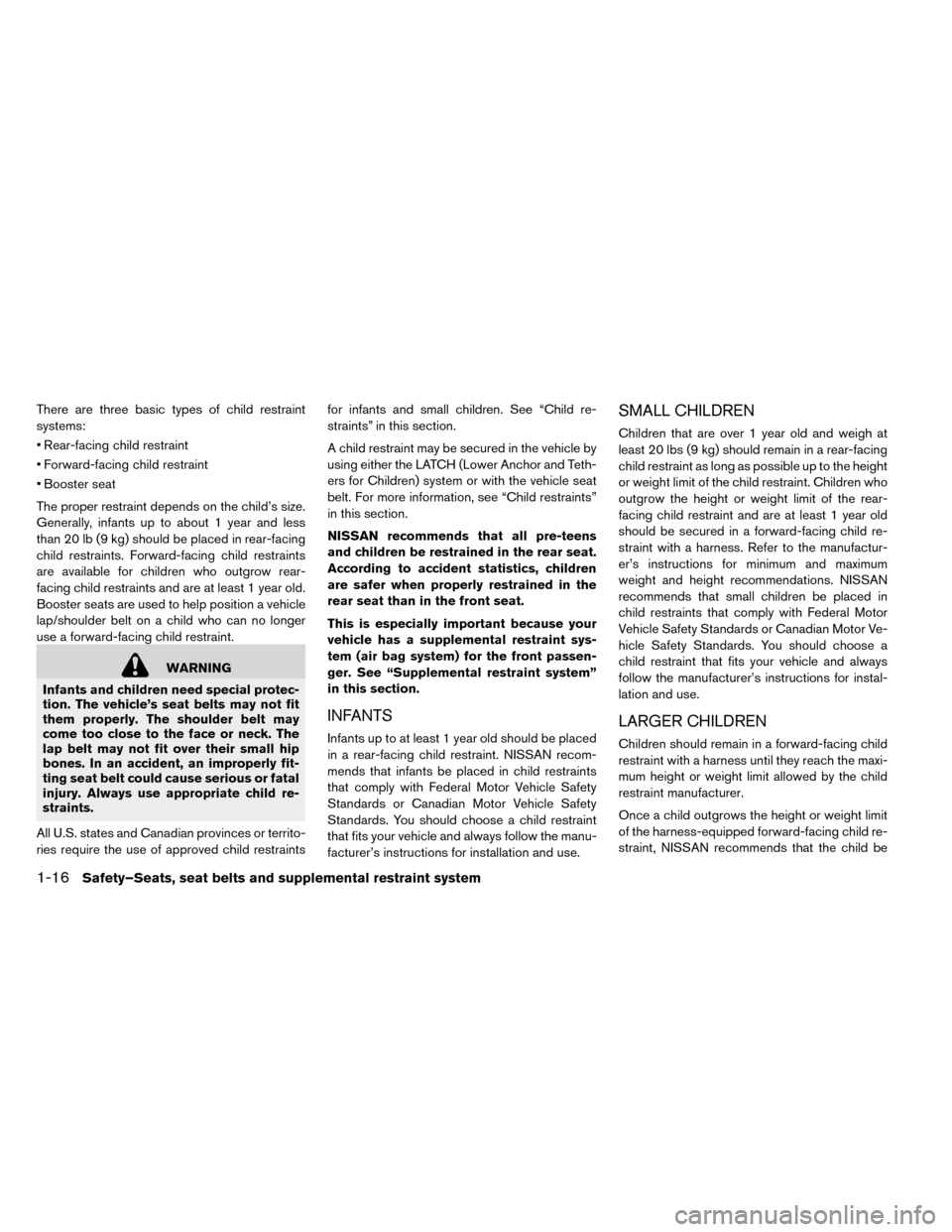
There are three basic types of child restraint
systems:
• Rear-facing child restraint
• Forward-facing child restraint
• Booster seat
The proper restraint depends on the child’s size.
Generally, infants up to about 1 year and less
than 20 lb (9 kg) should be placed in rear-facing
child restraints. Forward-facing child restraints
are available for children who outgrow rear-
facing child restraints and are at least 1 year old.
Booster seats are used to help position a vehicle
lap/shoulder belt on a child who can no longer
use a forward-facing child restraint.
WARNING
Infants and children need special protec-
tion. The vehicle’s seat belts may not fit
them properly. The shoulder belt may
come too close to the face or neck. The
lap belt may not fit over their small hip
bones. In an accident, an improperly fit-
ting seat belt could cause serious or fatal
injury. Always use appropriate child re-
straints.
All U.S. states and Canadian provinces or territo-
ries require the use of approved child restraints for infants and small children. See “Child re-
straints” in this section.
A child restraint may be secured in the vehicle by
using either the LATCH (Lower Anchor and Teth-
ers for Children) system or with the vehicle seat
belt. For more information, see “Child restraints”
in this section.
NISSAN recommends that all pre-teens
and children be restrained in the rear seat.
According to accident statistics, children
are safer when properly restrained in the
rear seat than in the front seat.
This is especially important because your
vehicle has a supplemental restraint sys-
tem (air bag system) for the front passen-
ger. See “Supplemental restraint system”
in this section.
INFANTS
Infants up to at least 1 year old should be placed
in a rear-facing child restraint. NISSAN recom-
mends that infants be placed in child restraints
that comply with Federal Motor Vehicle Safety
Standards or Canadian Motor Vehicle Safety
Standards. You should choose a child restraint
that fits your vehicle and always follow the manu-
facturer’s instructions for installation and use.
SMALL CHILDREN
Children that are over 1 year old and weigh at
least 20 lbs (9 kg) should remain in a rear-facing
child restraint as long as possible up to the height
or weight limit of the child restraint. Children who
outgrow the height or weight limit of the rear-
facing child restraint and are at least 1 year old
should be secured in a forward-facing child re-
straint with a harness. Refer to the manufactur-
er’s instructions for minimum and maximum
weight and height recommendations. NISSAN
recommends that small children be placed in
child restraints that comply with Federal Motor
Vehicle Safety Standards or Canadian Motor Ve-
hicle Safety Standards. You should choose a
child restraint that fits your vehicle and always
follow the manufacturer’s instructions for instal-
lation and use.
LARGER CHILDREN
Children should remain in a forward-facing child
restraint with a harness until they reach the maxi-
mum height or weight limit allowed by the child
restraint manufacturer.
Once a child outgrows the height or weight limit
of the harness-equipped forward-facing child re-
straint, NISSAN recommends that the child be
1-16Safety–Seats, seat belts and supplemental restraint system
Page 106 of 412
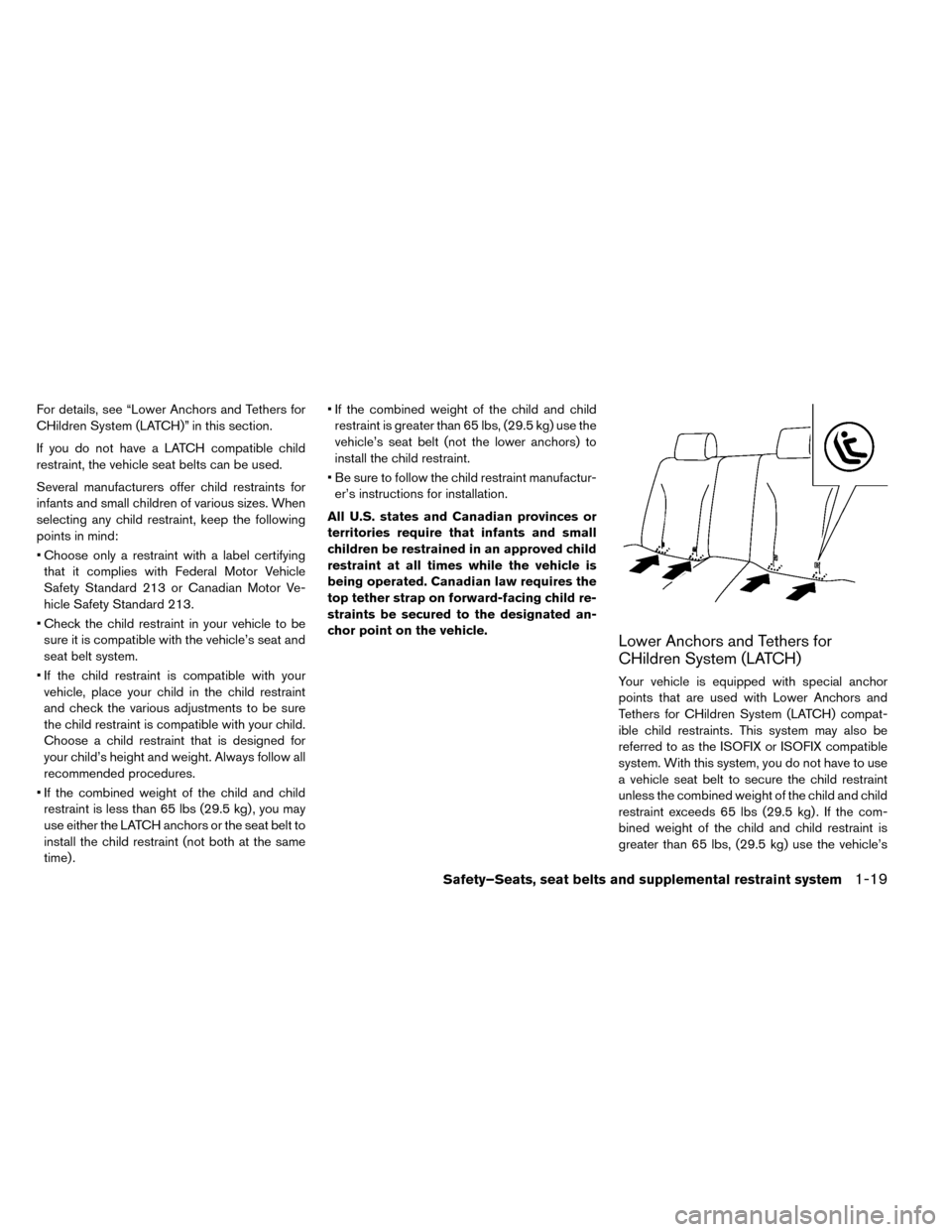
For details, see “Lower Anchors and Tethers for
CHildren System (LATCH)” in this section.
If you do not have a LATCH compatible child
restraint, the vehicle seat belts can be used.
Several manufacturers offer child restraints for
infants and small children of various sizes. When
selecting any child restraint, keep the following
points in mind:
• Choose only a restraint with a label certifyingthat it complies with Federal Motor Vehicle
Safety Standard 213 or Canadian Motor Ve-
hicle Safety Standard 213.
• Check the child restraint in your vehicle to be sure it is compatible with the vehicle’s seat and
seat belt system.
• If the child restraint is compatible with your vehicle, place your child in the child restraint
and check the various adjustments to be sure
the child restraint is compatible with your child.
Choose a child restraint that is designed for
your child’s height and weight. Always follow all
recommended procedures.
• If the combined weight of the child and child restraint is less than 65 lbs (29.5 kg) , you may
use either the LATCH anchors or the seat belt to
install the child restraint (not both at the same
time) . • If the combined weight of the child and child
restraint is greater than 65 lbs, (29.5 kg) use the
vehicle’s seat belt (not the lower anchors) to
install the child restraint.
• Be sure to follow the child restraint manufactur- er’s instructions for installation.
All U.S. states and Canadian provinces or
territories require that infants and small
children be restrained in an approved child
restraint at all times while the vehicle is
being operated. Canadian law requires the
top tether strap on forward-facing child re-
straints be secured to the designated an-
chor point on the vehicle.
Lower Anchors and Tethers for
CHildren System (LATCH)
Your vehicle is equipped with special anchor
points that are used with Lower Anchors and
Tethers for CHildren System (LATCH) compat-
ible child restraints. This system may also be
referred to as the ISOFIX or ISOFIX compatible
system. With this system, you do not have to use
a vehicle seat belt to secure the child restraint
unless the combined weight of the child and child
restraint exceeds 65 lbs (29.5 kg) . If the com-
bined weight of the child and child restraint is
greater than 65 lbs, (29.5 kg) use the vehicle’s
Safety–Seats, seat belts and supplemental restraint system1-19
Page 109 of 412
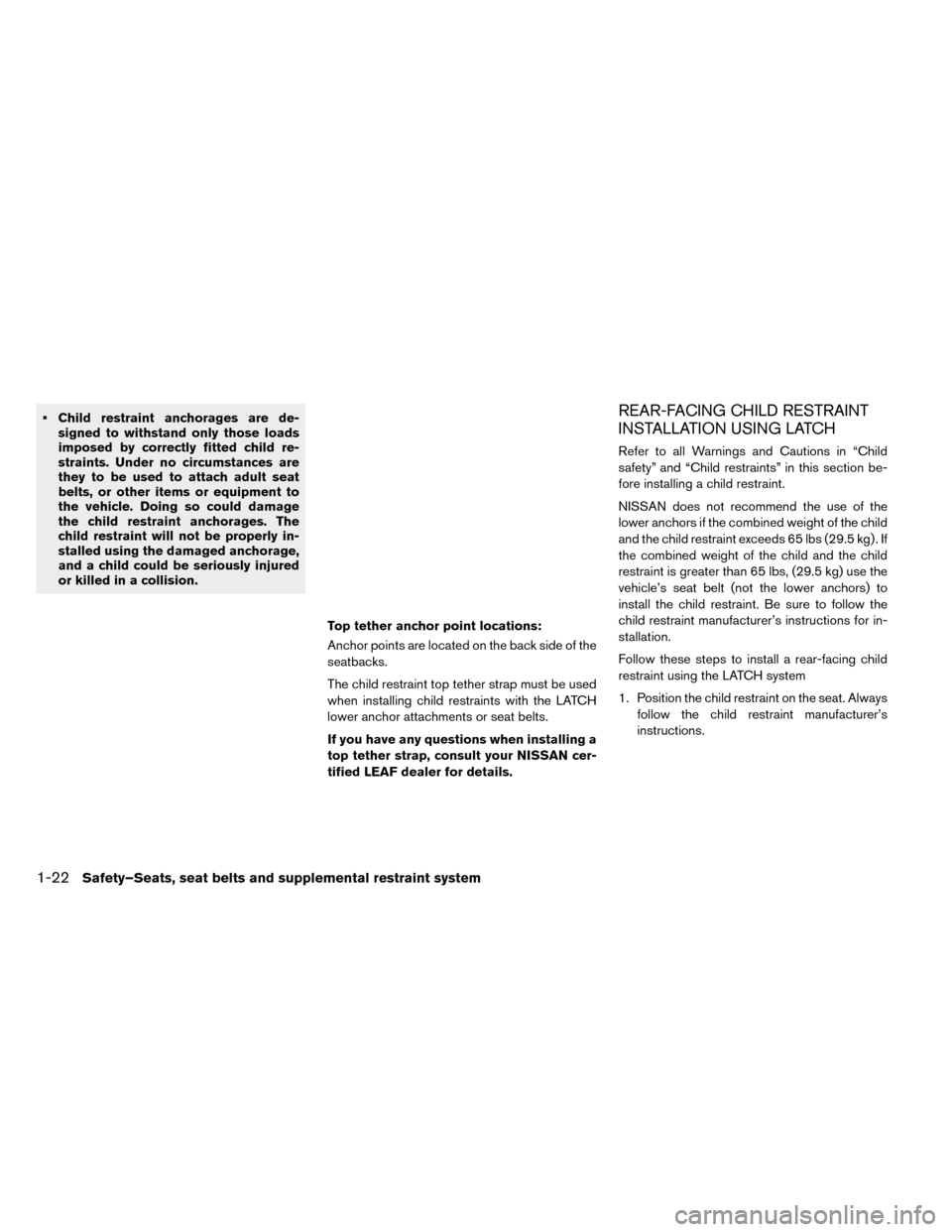
• Child restraint anchorages are de-signed to withstand only those loads
imposed by correctly fitted child re-
straints. Under no circumstances are
they to be used to attach adult seat
belts, or other items or equipment to
the vehicle. Doing so could damage
the child restraint anchorages. The
child restraint will not be properly in-
stalled using the damaged anchorage,
and a child could be seriously injured
or killed in a collision.
Top tether anchor point locations:
Anchor points are located on the back side of the
seatbacks.
The child restraint top tether strap must be used
when installing child restraints with the LATCH
lower anchor attachments or seat belts.
If you have any questions when installing a
top tether strap, consult your NISSAN cer-
tified LEAF dealer for details.REAR-FACING CHILD RESTRAINT
INSTALLATION USING LATCH
Refer to all Warnings and Cautions in “Child
safety” and “Child restraints” in this section be-
fore installing a child restraint.
NISSAN does not recommend the use of the
lower anchors if the combined weight of the child
and the child restraint exceeds 65 lbs (29.5 kg) . If
the combined weight of the child and the child
restraint is greater than 65 lbs, (29.5 kg) use the
vehicle’s seat belt (not the lower anchors) to
install the child restraint. Be sure to follow the
child restraint manufacturer’s instructions for in-
stallation.
Follow these steps to install a rear-facing child
restraint using the LATCH system
1. Position the child restraint on the seat. Alwaysfollow the child restraint manufacturer’s
instructions.
1-22Safety–Seats, seat belts and supplemental restraint system
Page 111 of 412

5. Check to make sure that the child restraint isproperly secured prior to each use. If the child
restraint is loose, repeat steps 2 through 4.REAR-FACING CHILD RESTRAINT
INSTALLATION USING THE SEAT
BELTS
WARNING
The three-point seat belt with Automatic
Locking Retractor (ALR) must be used
when installing a child restraint. Failure
to use the ALR mode will result in the
child restraint not being properly se-
cured. The restraint could tip over or be
loose and cause injury to a child in a
sudden stop or collision. Refer to all Warnings and Cautions in “Child
safety” and “Child restraints” in this section be-
fore installing a child restraint.
NISSAN does not recommend the use of the
lower anchors if the combined weight of the child
and the child restraint exceeds 65 lbs (29.5 kg) . If
the combined weight of the child and the child
restraint is greater than 65 lbs, (29.5 kg) use the
vehicle’s seat belt (not the lower anchors) to
install the child restraint. Be sure to follow the
child restraint manufacturer’s instructions for in-
stallation.
Rear-facing — step 4
1-24Safety–Seats, seat belts and supplemental restraint system
Page 114 of 412
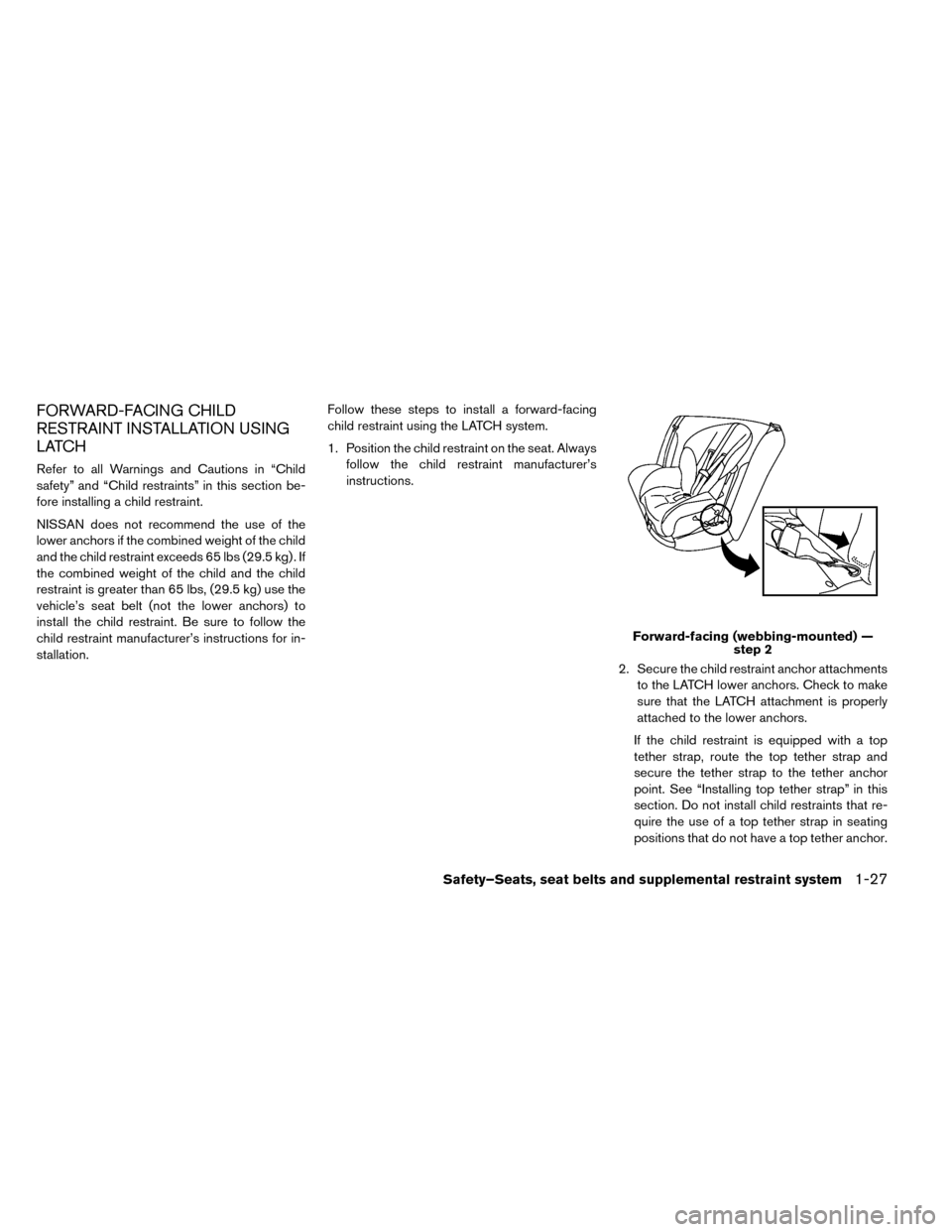
FORWARD-FACING CHILD
RESTRAINT INSTALLATION USING
LATCH
Refer to all Warnings and Cautions in “Child
safety” and “Child restraints” in this section be-
fore installing a child restraint.
NISSAN does not recommend the use of the
lower anchors if the combined weight of the child
and the child restraint exceeds 65 lbs (29.5 kg) . If
the combined weight of the child and the child
restraint is greater than 65 lbs, (29.5 kg) use the
vehicle’s seat belt (not the lower anchors) to
install the child restraint. Be sure to follow the
child restraint manufacturer’s instructions for in-
stallation.Follow these steps to install a forward-facing
child restraint using the LATCH system.
1. Position the child restraint on the seat. Always
follow the child restraint manufacturer’s
instructions.
2. Secure the child restraint anchor attachmentsto the LATCH lower anchors. Check to make
sure that the LATCH attachment is properly
attached to the lower anchors.
If the child restraint is equipped with a top
tether strap, route the top tether strap and
secure the tether strap to the tether anchor
point. See “Installing top tether strap” in this
section. Do not install child restraints that re-
quire the use of a top tether strap in seating
positions that do not have a top tether anchor.
Forward-facing (webbing-mounted) — step 2
Safety–Seats, seat belts and supplemental restraint system1-27
Page 116 of 412

7. Check to make sure the child restraint is prop-erly secured prior to each use. If the child
restraint is loose, repeat steps 1 through 6.
FORWARD-FACING CHILD
RESTRAINT INSTALLATION USING
THE SEAT BELTS
WARNING
The three-point seat belt with Automatic
Locking Retractor (ALR) must be used
when installing a child restraint. Failure
to use the ALR mode will result in the
child restraint not being properly se-
cured. The restraint could tip over or be
loose and cause injury to a child in a
sudden stop or collision. Also, it can
change the operation of the front passen-
ger air bag. See “Front passenger air bag
and status light” in this section. Refer to all Warnings and Cautions in “Child
safety” and “Child restraints” in this section be-
fore installing a child restraint.
NISSAN does not recommend the use of the
lower anchors if the combined weight of the child
and the child restraint exceeds 65 lbs (29.5 kg) . If
the combined weight of the child and the child
restraint is greater than 65 lbs, (29.5 kg) use the
vehicle’s seat belt (in place of not the lower
anchors) to install the child restraint. Be sure to
follow the child restraint manufacturer’s instruc-
tions for installation. Follow these steps to install a forward-facing
child restraint using the vehicle seat belt in the
rear seat or in the front passenger seat:
1.
If you must install a child restraint in the
front seat, it should be placed in the
forward-facing direction only. Move the
seat to the rearmost position. Child re-
straints for infants must be used in the
rear-facing direction and therefore must
not be used in the front seat.
2. Position the child restraint on the seat. Always follow the child restraint manufacturer’s
instructions.
The back of the child restraint should be se-
cured against the seatback.
If necessary, adjust the head restraint/
headrest (front passenger seat only) or re-
move the head restraint/headrest to obtain the
correct child restraint fit. If the head restraint/
headrest is removed, store it in a secure place.
Be sure to reinstall the head restraint/
headrest when the child restraint is re-
moved. See “Remove”, “Install”, or “Adjust”
under “Head restraints/headrests” for head
restraint/headrest adjustment, removal and in-
stallation information.
Forward-facing (front passenger seat) — step 1
Safety–Seats, seat belts and supplemental restraint system1-29
Page 125 of 412
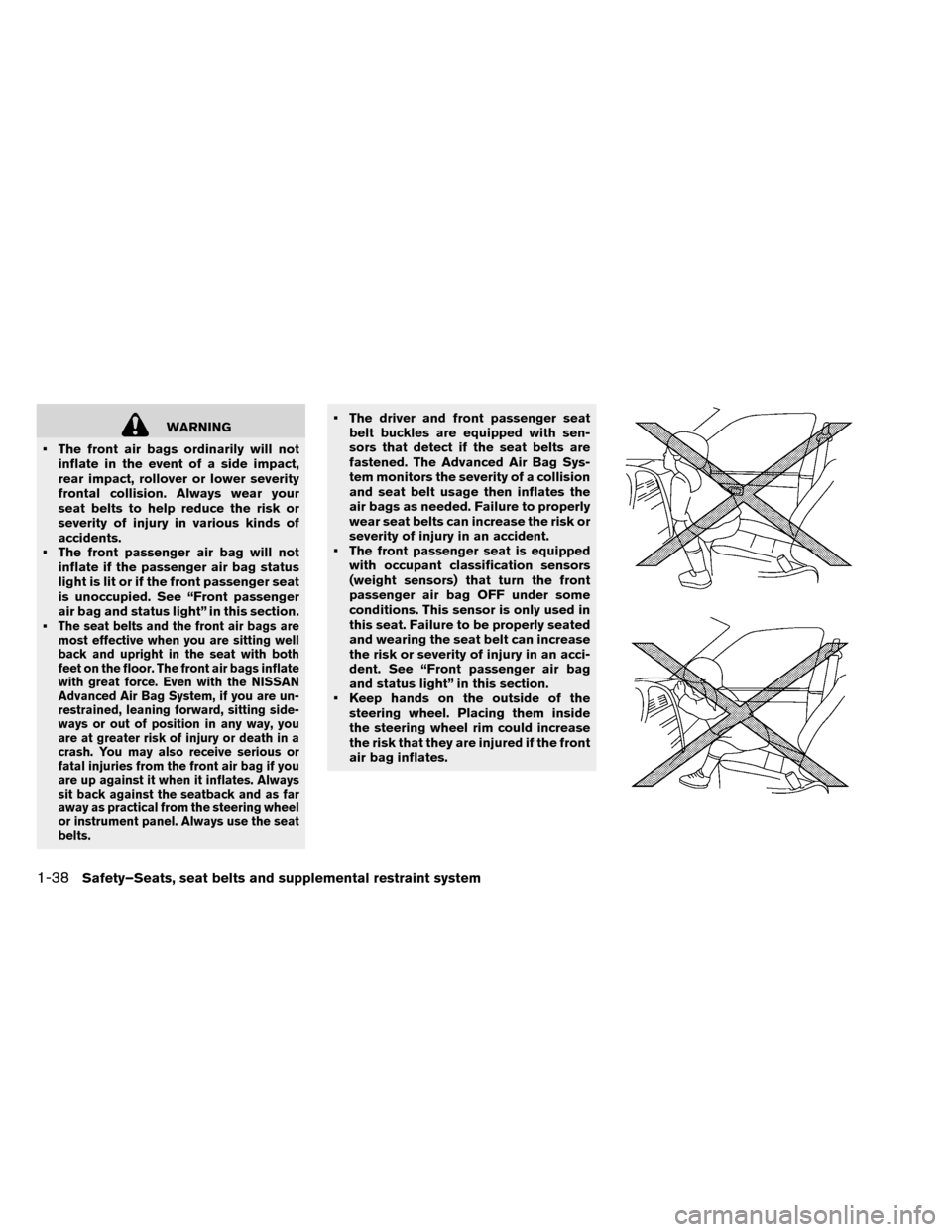
WARNING
• The front air bags ordinarily will not inflate in the event of a side impact,
rear impact, rollover or lower severity
frontal collision. Always wear your
seat belts to help reduce the risk or
severity of injury in various kinds of
accidents.
• The front passenger air bag will not inflate if the passenger air bag status
light is lit or if the front passenger seat
is unoccupied. See “Front passenger
air bag and status light” in this section.
•
The seat belts and the front air bags are
most effective when you are sitting well
back and upright in the seat with both
feet on the floor. The front air bags inflate
with great force. Even with the NISSAN
Advanced Air Bag System, if you are un-
restrained, leaning forward, sitting side-
ways or out of position in any way, you
are at greater risk of injury or death in a
crash. You may also receive serious or
fatal injuries from the front air bag if you
are up against it when it inflates. Always
sit back against the seatback and as far
away as practical from the steering wheel
or instrument panel. Always use the seat
belts.
• The driver and front passenger seat belt buckles are equipped with sen-
sors that detect if the seat belts are
fastened. The Advanced Air Bag Sys-
tem monitors the severity of a collision
and seat belt usage then inflates the
air bags as needed. Failure to properly
wear seat belts can increase the risk or
severity of injury in an accident.
• The front passenger seat is equipped with occupant classification sensors
(weight sensors) that turn the front
passenger air bag OFF under some
conditions. This sensor is only used in
this seat. Failure to be properly seated
and wearing the seat belt can increase
the risk or severity of injury in an acci-
dent. See “Front passenger air bag
and status light” in this section.
• Keep hands on the outside of the steering wheel. Placing them inside
the steering wheel rim could increase
the risk that they are injured if the front
air bag inflates.
1-38Safety–Seats, seat belts and supplemental restraint system